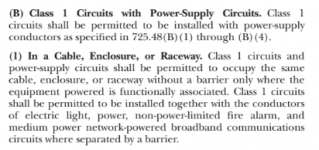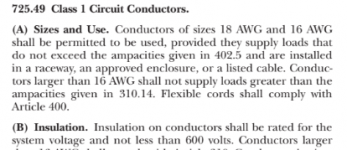jaggedben
Senior Member
- Location
- Northern California
- Occupation
- Solar and Energy Storage Installer
...
-
So what would it take to get 18 gauge communication wire in the same existing conduit as 40A 240V power delivery?
You could try making your own twisted pair with class 1 conductors. (See discussion in that thread.) Hopefully interference isn't a problem.
I agree with Larry and others that the meter which takes the CT secondaries as input and outputs the RS-485 should not be in the panel. The proper location would be a j-box adjacent to the panel. The RS-485 could leave by a different direction and rejoin the 40A EV circuits in a T-condulet.
I just told you. A cable rated at 600V! You said you had a source for it didn't you?
I believe it either has to be listed by the manufacturer or Class 1 conductors. For example there is Cat6 with an outer 600V jacket, but that's not code compliant unless listed. I believe it will work fine, and I've used it with high voltage DC with manufacturers blessing (although in retrospect, I'm a bit skeptical they got it listed).


